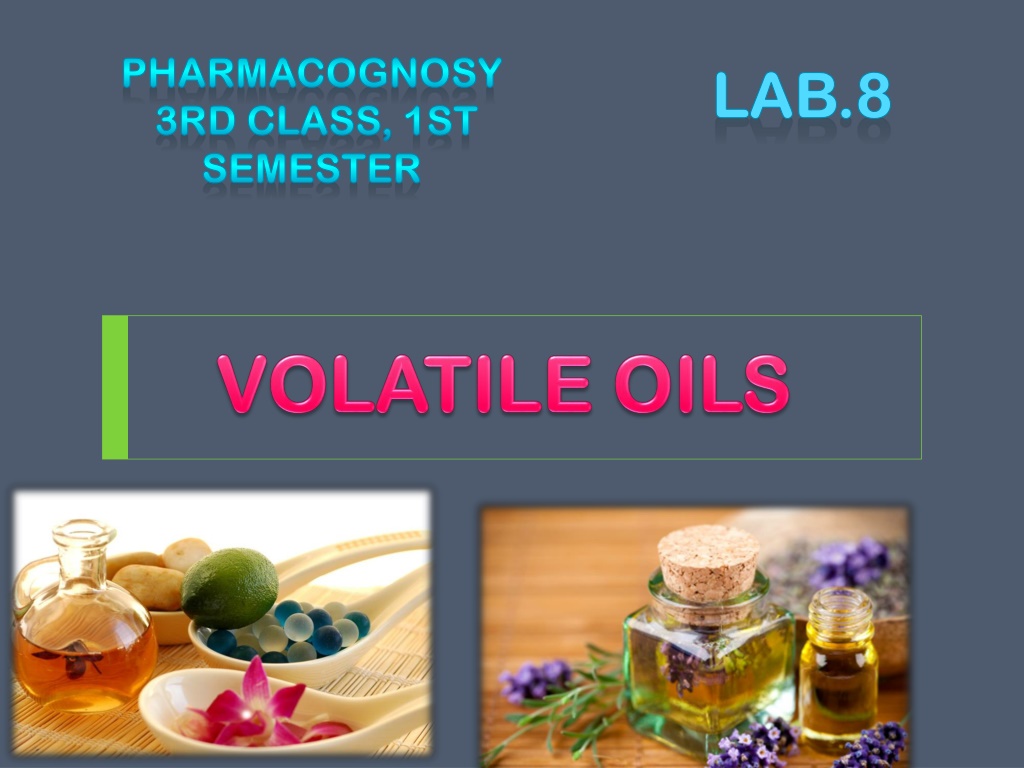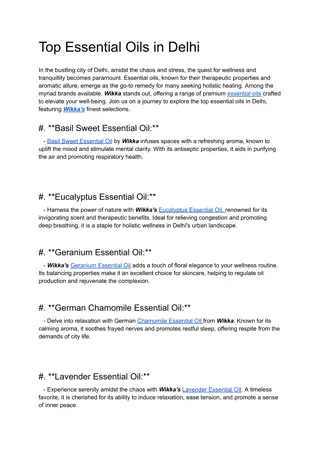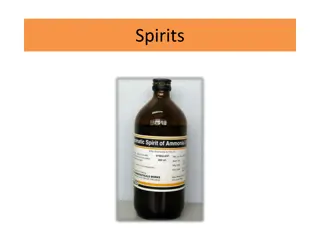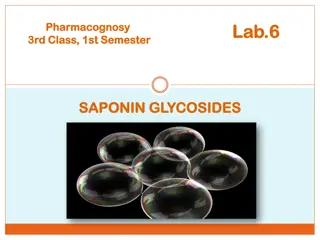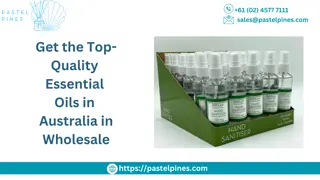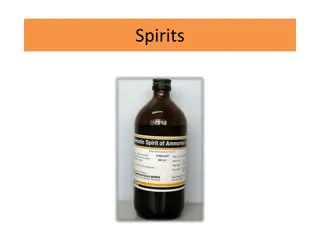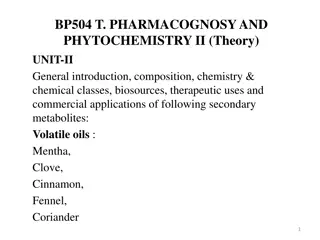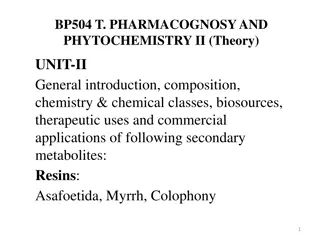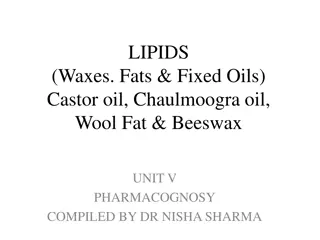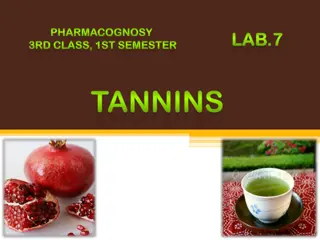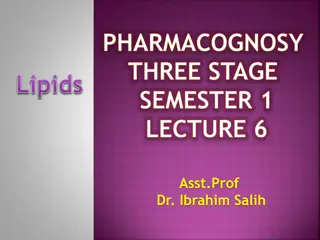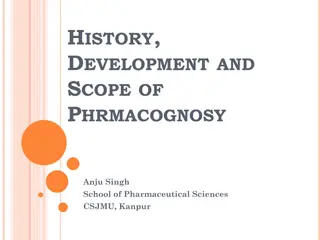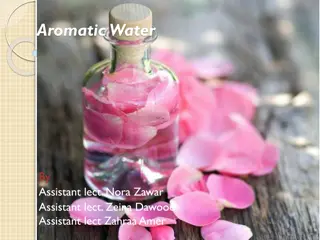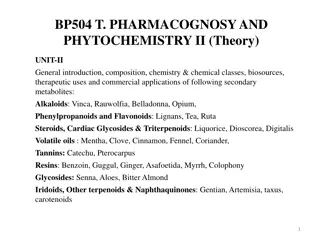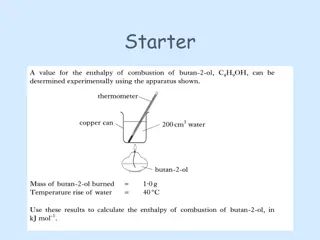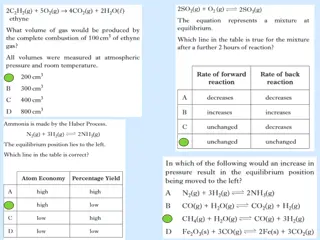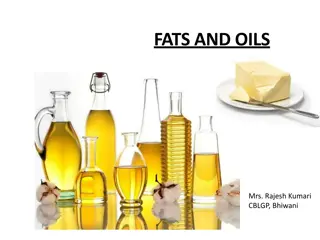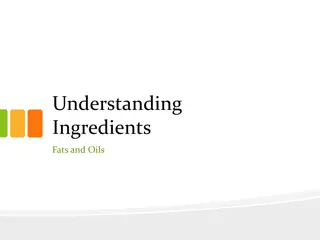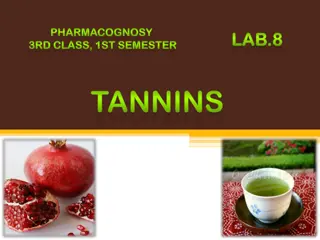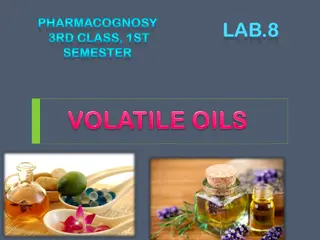Understanding Volatile Oils in Pharmacognosy: Properties, Composition, and Uses
Volatile oils, also known as essential oils, are complex plant products containing volatile principles. They are colorless but may darken over time. Immiscible with water, they have distinct odors and tastes, and are soluble in organic solvents. Officially sourced from plants, volatile oils have therapeutic, flavoring, and aromatic uses. They contain terpene derivatives and aromatic compounds responsible for their properties. Learn more about their chemical composition and applications.
Download Presentation

Please find below an Image/Link to download the presentation.
The content on the website is provided AS IS for your information and personal use only. It may not be sold, licensed, or shared on other websites without obtaining consent from the author. Download presentation by click this link. If you encounter any issues during the download, it is possible that the publisher has removed the file from their server.
E N D
Presentation Transcript
PHARMACOGNOSY PHARMACOGNOSY 3RD CLASS, 1ST 3RD CLASS, 1ST SEMESTER SEMESTER LAB.8 LAB.8
Introduction Volatile oils are products which are generally complex in composition, consisting of the volatile principles contained in plants. Because they evaporate when exposed to the air room temperatures, they are called volatile oils, they are also called essential oils or ethereal oils. Volatile oils are colorless as a rule, particularly when they are fresh, but on long standing they are may oxidize and resinify, thus darkening in color to prevent this darkening, they should be stored in a cool, dry place in tightly stoppered, preferably full, amber glass containers.
Cont As a rule volatile oils are immiscible with water or Slightly soluble in water just give it a characteristic odour & taste, but they are soluble in ether, alcohol and most organic solvents. Chemically and physically different from fixed oils (Sunflower oil is the fixed oil obtained from the seed of the sunflower ) :- Not glyceryl esters of fatty acids. Do not leaves permanent grease spot in paper. Not saponified with alkali. Not become rancid but on exposure to air and light becomes oxidized and resinify.
Cont All official volatile oils are of vegetable origin normally pre-exist in the plant stored in a special secretary tissue ,oil glands, oil cells, glandular hairs. EXCEPTION: Oil of bitter almond formed by hydrolysis of the glycosides.
Uses Of Volatile Oils Therapeutically administered by:- Inhalation (Eucalyptus oil). Orally (Peppermint oil). Gargle and mouthwash (Thymol oil). Transdermal (Lavender, Rosemary). Flavouring Flavouring (Oil of Lemon) Perfumery Perfumery (Oil of Rose) Starting materials Starting materials to synthesize other compounds . Anti Anti- -septic septic due to high phenols (Oil of Thyme). Also as a preservative. Anti Anti- -spasmodic spasmodic (Ginger, Rosemary, Peppermint). Aromatherapy Aromatherapy is the treatment or prevention of disease by use of essential oils and other uses include pain and anxiety reduction, enhancement of energy and short-term memory, relaxation, hair loss prevention. a) b) c) d)
Chemical Composition Terpene derivatives (terpenes are natural products whose structures may be divided into isoprene units formed via the acetate mevalonic acid pathway) for ex: Limonene and Menthol. 1) Aromatic compounds (formed via the shikimic acid-phenylpropanoid route) for ex: Vanillin. 2) Many volatile oils are largely monoterpenoids and others phenylterpenoids. Constituents are responsible for their characteristic odor, taste, flavor and therapeutic properties.
Cont Note: Shikimic acid more commonly known as its anionic form shikimate. It is an important biochemical metabolite in plants and microorganisms. Its name comes from the Japanese flower shikimi.
Cont Generally volatile oils containing drugs are divided into the following classes:- a) Hydrocarbons b) Alcohols c) Aldehydes d) Ketones e) Phenols Phenolic ethers g) Oxides h) Esters f)
Methods of obtaining volatile oils Methods of obtaining volatile oils 1. Steam Distillation: This method is applied to fresh plants for ex: peppermint. 2. Expression: Mostly the citrus oil is obtained by this method. 3. Enfleurage method: This method is especially used for those volatile oils, which are present in such a part which is very small and also liable to decomposition on distillation. 4. Enzymatic hydrolysis: Glycosidic volatile oils like bitter almond, mustard oil is obtained by enzymatic hydrolysis of glycosides. 5. Solvent extraction: This is very costly method and is mostly used in perfume industry. The parts containing volatile oil are extracted directly by one of the organic solvents and they are then separated.
Determination of the volatile content of crude drugs by steam distillation method Apparatus: - Clevenger apparatus is used to determine the volatile oil content in a given sample. The oil layer settles on top of the aqueous layer.
Cont Procedure:- 1) Weight out 20gm of the plant material (coarse powder)and place into a distilling flask. 2) Add few pieces of porous earthenware. 3) Add 200ml distilled water to the flask and shake well. 4) Connect the distilling flask with the still head of the apparatus. 5) Heat the distilling flask until the boiling starts. 6) Record the time of the beginning of distillation and continue the distillation for one hour. 7) Switch off heating allow the graduated receiver to cool read off the volume of the volatile oil(count all small divisions in the receiver of the layer of oil). 8) Calculate the %v/w of the volatile oil content of the drug.
TLC Technique in the identification of Volatile TLC Technique in the identification of Volatile Oil Oil Peppermint oil Stationary phase=silica gel G Mobile phase= chloroform :benzene (1:1) Spray reagent =dinitrophenyl hydrazine. Standard reagent=peppermint oil Measure Rf Value
